When you think about South America you tend to assume there are plenty of deadly critters out there. A lot of this stems from the fact that the northeastern corner of the continent is dominated by the immense and impenetrable Amazon Jungle. To be honest, it would have been a bit of a challenge to come up with a list of potentially deadly animals if it weren’t for the Amazon; while it may be possible to be trampled to death by llamas or carried away by a condor the only real concentration of dangerous animals is the mighty river and rainforest.
Many of the animals in this list are unique to this part of the world, although some have their equivalents in other places. A few will already have made it onto various lists on Planet Deadly but most are specific to this corner of the globe.
10. Green Anaconda
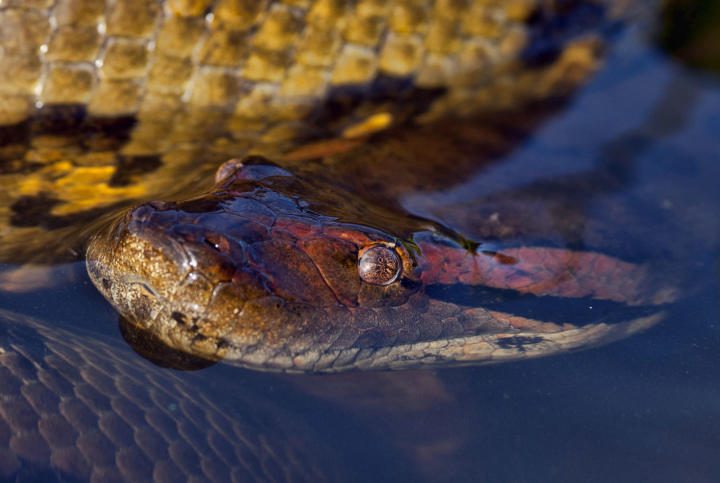
If there were a competition for which infamously deadly South American animal has killed the least people it would be a toss up between the piranha and the anaconda, or maybe even the notorious candiru! On paper there is little doubt these animals are incredibly dangerous yet statistically speaking they don’t actually seem to kill anyone.
There is little doubt an anaconda could kill a person. Weighing in at over 500lb (250kg) of solid muscle the green anaconda is the heaviest snakes in the world. They are also one of the longest with some specimens measuring over 20ft (7m).
The anaconda hunts by ambushing its prey from the water. Like crocodiles they will wait, largely submerged, for their prey to come within striking range at which point they will launch a lightning attack. As opposed to powerful jaws the anaconda the snakes main weapon is its body which it uses to coil around the prey and literally squeezes the life out of it. They are not venomous but have sharp, backwards pointing teeth for initially grabbing their prey.
In the wild anacondas feed on virtually any animal they can catch including pigs, deer and even caiman. The deer they have been recorded eating are at least as big as a small adult human which further validates their potential to kill.
One oft cited reason they do not kill people is they would not be able to get the shoulders through their mouth. This is actually a myth and they have incredibly flexible mouth ligaments along with the strength to disarticulate the shoulders if they needed to.
As far as our research goes there have only been two recorded predatory attacks by anacondas, and both these were on people studying them in the field. It is highly likely that the figures are so low because human and snake habitats have very little overlap; but it is also likely that this may change as environmental pressures increase on the anacondas domain.
9. Red-bellied Piranha

The piranha is one of the most notorious man-eaters of all. Armed with razor-sharp teeth and prone to swarming in feeding frenzies at the first drop of blood these fish have a fearsome reputation of being able to strip a man to the bone in a matter of seconds.
However, the truth doesn’t quite live up to the legend. Yes, there have been a couple of deadly attacks by piranhas over the years but this hardly makes them the terror of the Amazon. And they are certainly capable of inflicting some nasty injuries but how did they come to be so feared?
The piranha’s legendary status as a killer largely dates back to the late 1900s when Theodore Roosevelt (former president of America) visited the Amazon. Local fishermen arranged a display of the piranhas ferocious behaviour for Roosevelt. They had blocked off an area of water and starved the piranhas in it for several days. An unfortunate cow was then pushed into the water whereupon the piranhas lived up to their reputation and promptly stripped it to the bone. Unaware that the episode had been set up for his benefit Roosevelt wrote about the killer fish and the rest is history.
8. Black Caiman
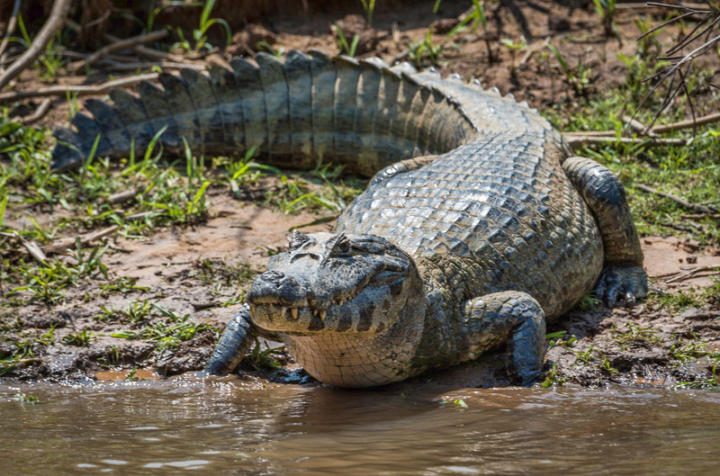
South America is home to several crocodilian species at least three of which can be considered dangerous to humans. These are the American crocodile, Orinoco crocodile and the black caiman. All can grow to around 20ft (6m) in length making them some of South America’s apex predators and at least the size of an American alligator.
Out of the three species the black caiman is the most widespread and common on the continent; the American crocodile is more common in Central America while the Orinoco crocodile is critically endangered. So, the chances are, if you are going to meet an enormous crocodile in South America it is likely to be the black caiman.
There is little doubt these caiman are capable of killing humans. Larger specimens have been observed to prey on virtually anything that comes into their range. This includes other caiman, deer, tapirs, anacondas, giant otters and various farm animals. Reports of caiman taking jaguars are also not unheard of, although it can often be the other way around.
Given this it is not surprising that there are several fatal attacks occur each year in the Amazon region.
7. Golden Dart Frog
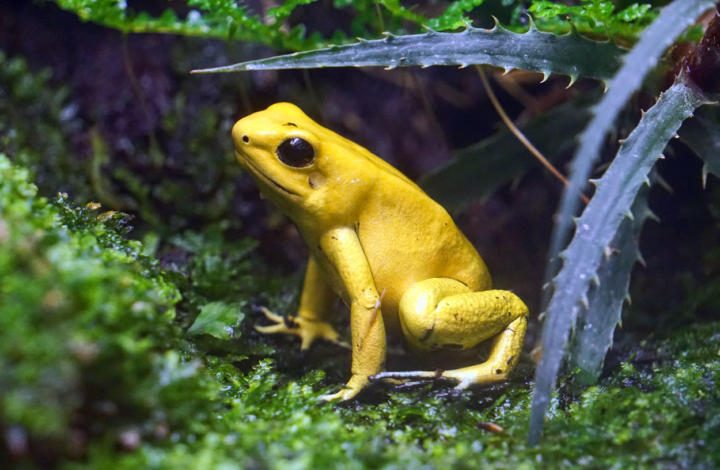
Bright yellow in color, the golden poison dart frog does little to hide itself among the jungles of Colombia. Quite the opposite in fact, this little frog advertises the fact that it is the most poisonous vertebrate on earth.
The frog is poisonous, not venomous; that is it does not have any mechanism such as fangs or a sting to deliver its poison. Instead the golden poison frog’s skin is coated in a powerful alkaloid toxin known as batrachotoxin. This poison works by blocking the victims nerve impulses resulting in paralysis and possible heart failure. It is estimated the poison from one frog would be enough to kill between 10 and 100 humans or 20,000 mice. Only one animal is known to be immune to this toxin – the frog itself!
Interestingly enough poison dart frogs bred in captivity are not toxic. This indicates that they produce their lethal poison from the ants and beetles that they eat, suggesting one of these may be even more poisonous.
6. Giant Otter
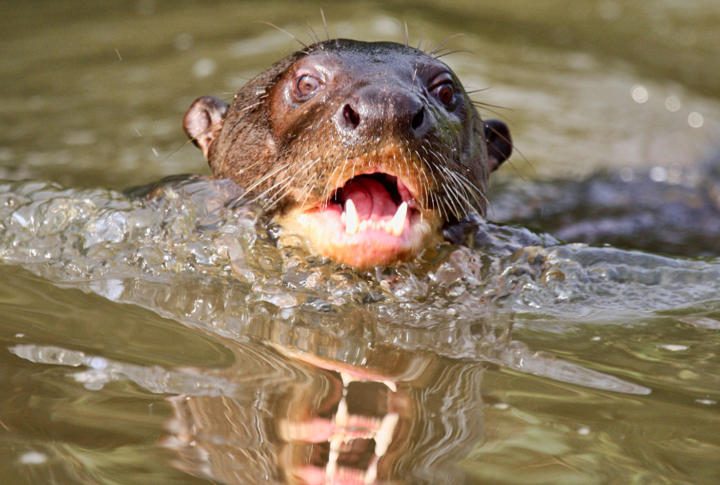
The giant otter is the largest member of the mustelid family. This is the family of carnivorous mammals with a reputation of punching well above its weight. Containing species such as wolverines, badgers and weasels these animals are well known for tackling prey far bigger than themselves.
Measuring up to 5.6ft (1.7m) in length and weighing up to 32kg (70lb) the giant otter is solid muscle armed with powerful jaws and sharp teeth. What is more they operate in family groups of up to ten individuals giving them the local name of ‘river wolves’. Fast, aggressive and intelligent, the giant otter has few natural predators.
The majority of the otter’s diet is made up of fish although they will occasionally take smaller caiman and even anacondas. In groups the otters are capable of taking on almost anything the river and jungle can throw at them, including larger caiman.
So, there is little doubt giant otters would make short work of a human should one enter their domain. But would they?
There are two cases of serious attacks on humans by giant otters. The first occurred in Brasilia zoo in 1977 when a 13 year old boy fell into the otter enclosure. A passing army sergeant, Silvio Hollembach jumped in to rescue the child but was set upon himself. Whilst the boy escaped Sgt Hollembach was attacked by the 6 otters resulting in more than a hundred bites. He died in hospital two days later from sepsis due to infection from the bites.
This is not the only case of a captive giant otter causing serious injury to a human. In 2012 a giant otter escaped from its enclosure in Hamburg zoo and attacked a cleaning lady. The bites to her arms and legs were so severe that she was hospitalised and put in an induced coma. If it hadn’t been for the intervention of two zoo keepers things might have been far worse.
5. Brazilian Wandering Spider
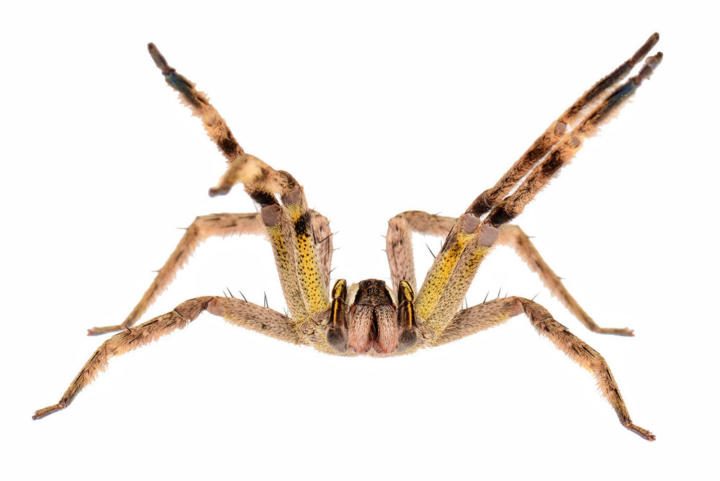
The scientific name of the Brazilian wandering spider is Phoneutria meaning murderess. This hints at the fact that this notorious arachnid is often ranked as the most dangerous spider in the world. Ranked as the most venomous spider on earth by Guinness World Records the bite of the wandering spider is more akin to a snake bite. The powerful neurotoxin is around 20 times more potent than that of the black widow spider and can cause a loss of muscle control leading to breathing difficulties and in some cases fatal respiratory paralysis.
As well as the potentially lethal neurotoxic effects of the bite it is also said to be intensely painful. But that isn’t all. One unfortunate side effect of the Brazilian wandering spider bite is a paiful erection that can last for several hours.
There is no denying the danger of being bitten by one of these spiders and there have been a number of deaths over the years. What makes them particularly dangerous is the fact they often come into contact with humans and are quite aggressive. As the name suggests these spiders wander turning up in all manner of hiding places; boots, piles of clothes, log piles, cars and bunches of bananas – which is why they are sometimes referred to as “banana spiders”.
4. Jaguar
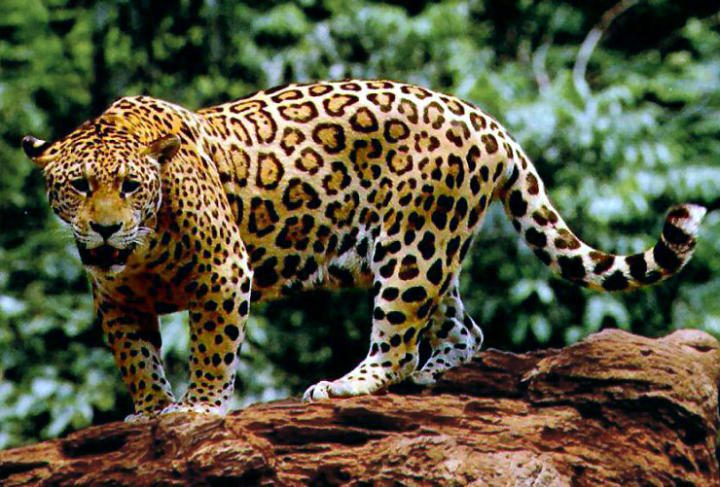
The jaguar is the apex predator of the South American jungles and forests, sitting firmly at the top of the food chain. It is the third largest of all the big cats coming in below tigers and lions, weighing up to 300lbs (150kg) and measuring over 6ft (1.85m) from nose to base of the tail. The jaguar is rather stocky and compact compared to the other big cats which in practical terms means it is powerful for its size.
This power can be seen in the animal’s bite; pound for pound it has the strongest bite of any big cat, something which it often employs in its hunting strategy. While other members of the cat family go for the throat grab and suffocate killing method the jaguar will employ its crushing jaws to bite through the skull of its prey, piercing the brain. The powerful bite also allows it to take on armoured prey such as armadillos and turtles, and it makes short work of the thick skin of caimans.
It seems that nothing is off the menu for the jaguar with even black bears being hunted by one individual in the United States. This said there does seem to be a certain reluctance by the jaguar to attack people. Over the years there have been a few cases of fatal attacks by jaguars but these amount to less than one death per year.
It seems that whilst the jaguar has no problem making a meal out of humans, for the time being they prefer to steer clear of conflict.
3. Common Lancehead
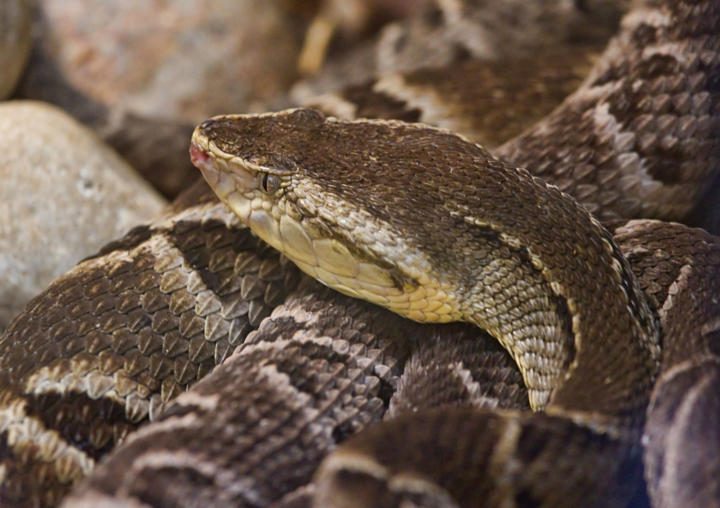
The lanceheads are the snakes that cause the majority of snakebite deaths in South America. Besides their speed and “excitable nature” what makes this group of pit-vipers particularly dangerous is the fact they are often found in populated areas.
Perhaps the most notorious of the lanceheads are the common lancehead (B. atrox), the terciopelo (B. asper) and the jararaca (B. jararaca). Both are large snakes, measuring around 2 metres (6.5ft) and both have the same hemotoxic venom.
Many of the world’s most dangerous snakes have neurotoxic venom which works by blocking nerve signals and causing paralysis. Hemotoxic venom, on the other hand, breaks down the bodies tissues and destroys blood cells. As you can imagine this is far more painful and can result in serious damage to the body. In fact many victims require limb amputations, even after effective treatment.
The chance of dying from the bite from a lancehead is around 1% if treated rising to nearly 10% if not. Given that there are around a thousand snakebites from these snakes each year that represents a significant number of deaths. The bite itself will cause local swelling, vomiting and pain often followed by blistering and bruising. Systemic symptoms usually involve hemorrhaging internally and from the gums, eyes etc. Whilst this may lead to fatal shock, death may also result from kidney failure.
2. Sharks
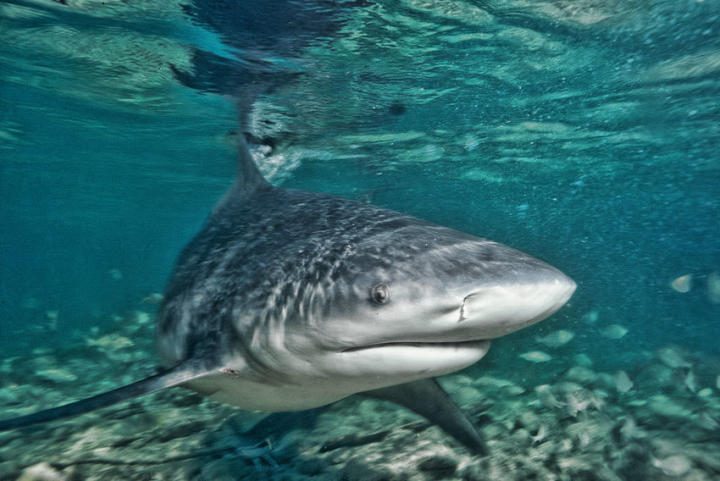
When asked where the most notorious shark-infested waters on the planet are people tend to think of Australia, South Africa or even Florida. They may also think of the great white shark as the main culprit. They would be wrong. Brazil has one of the highest rate of shark attacks in the world and the highest rate of fatal attacks.
In general the incidence of shark attacks on Brazilian beaches is nothing unusual. However, if you travel to the northeastern city of Recife things take a turn very much for the worse. The coast around here has been plagued by deadly shark attacks for the last 20 years. There have been over 60 attacks during this time with 22 of these fatal. That equates to a fatality rate of over a third – the worldwide average is closer to 16%. These days surfing at Recife’s beaches is banned and nobody swims off the city’s beaches.
There is no conclusive data on which species have been responsible for every attack but two of the usual suspects have been firmly implicated. Firstly, bull sharks which live close to the coast and in the estuaries. Then there are the tiger sharks, which are more likely to be found in deeper water.
Prior to 1992 this area of Brazil had no more shark attacks than anywhere else in the country. So what changed?
A lot of people blame the development of the port to the south of Recife which has caused large scale disruption to the local marine life. Local estuaries were dredged and the level of shipping increased over the years. The damage to the local environment is seen as one cause for the bull shark attacks where as the rubbish thrown overboard ships is thought to bring in the tiger sharks which follow the ships.
The bad news is there are plans for a further port north of Recife, so things might get a whole lot worse before they get any better.
1. Kissing Bug
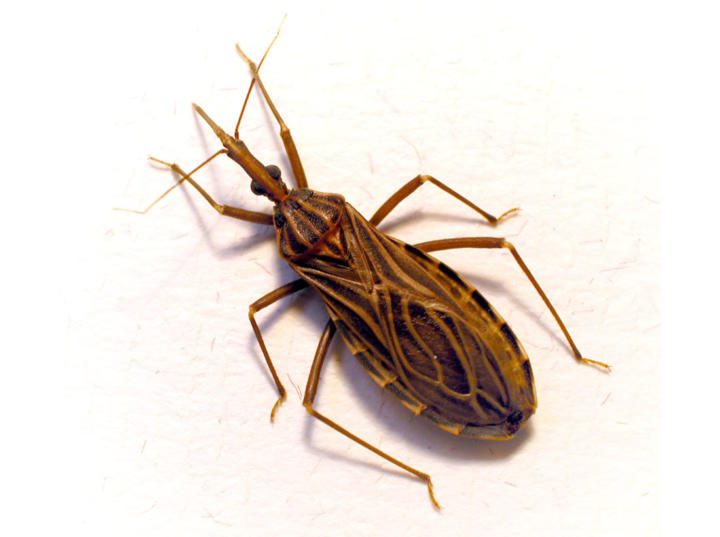
So here we have it; the most dangerous animal in South America isn’t one of the terrors of the Amazon basin. Instead it is a bug with a rather appealing name – the kissing bug. Actually this insect has a few other names that make it sound a little less desirable; the assassin bug and vampire bug are two of these and should give some indication of what they get up to.
Measuring around and inch (2.5cm) in length these bugs (Triatominae) are bloodsuckers. But, unpleasant as that makes them, this is not the reason they are at the top of our list of South America’s most dangerous animals. The reason is that kissing bugs are the primary carriers of the parasite that causes Chagas disease. It isn’t actually the bite of the bug that transmits the illness, it is the fact that they like to defecate on their human host. Scratching the bite then helps introduce the parasite in the bugsh*t through the wound.
Chagas disease is endemic throughout South America and kills more people than any other parasite-borne disease on the continent – and that includes malaria. It is estimated that around 7 million people are infected with Chagas disease and there are approximately 7,000 deaths each year as a result.
The cause of Chagas disease is a relative of the protozoan responsible for African sleeping sickness, Trypanosoma cruzi. The infection has two stages; an acute stage which happens straight away and a chronic stage which can persist for life and cause serious problems decades down the line.
The majority of people who are infected will show no symptoms and may be completely unaffected. However, around 30% will have medical issues later in life with a large percentage of these going on to develop potentially fatal heart and neurological conditions.
There is no cure for Chagas disease once it is established, although early treatment can stop this happening.
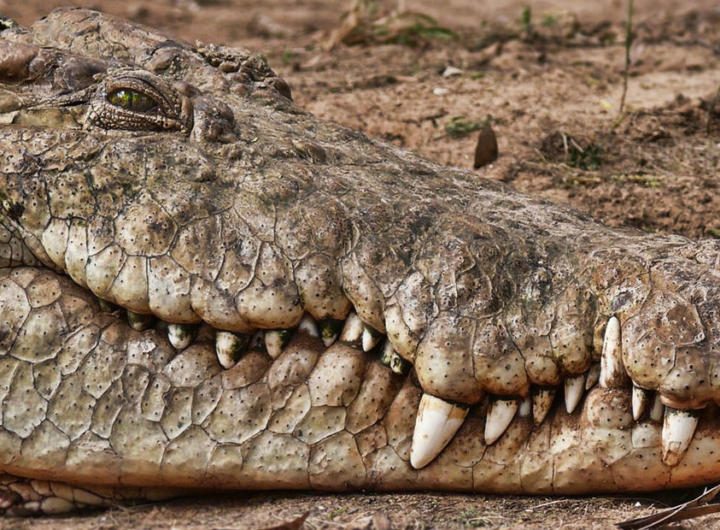
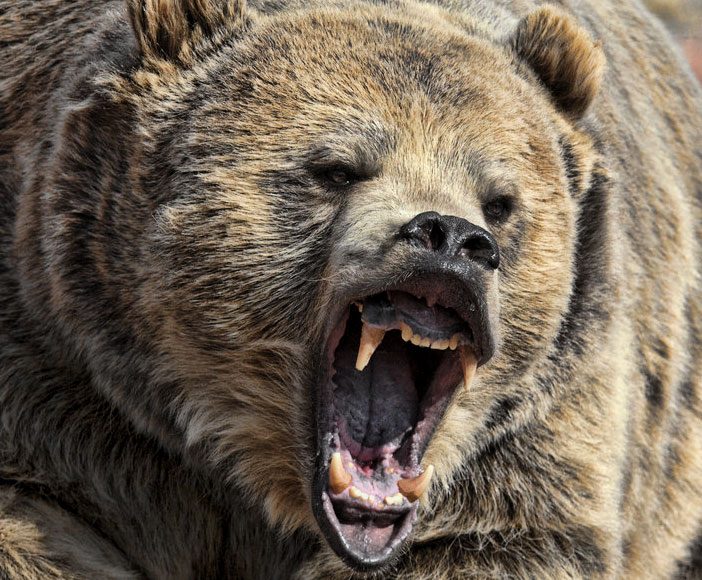

the real top ten dangerous animals in South America
10. anaconda
9. bull shark
8. killer bees
7. jaraca pit viper
6. american crocodile
5. vampire bat
4. assassin bug
3. poison dart frog
2. mosquito
1. fer de lance
I agree 😉
fer-de-lance?
Thought one lancehead was probably enough. Worth a mention though – maybe I’ll include it in a Central America list sometime…
Is there anything else interesting or dangerous or even worth visiting/living there that one should be aware of or curious about? I myself am curious to know more about South America.